RFID keeps getting smaller. On February 13, Hitachi unveiled a tiny, new "powder" type RFID chip measuring 0.05 x 0.05 mm -- the smallest yet -- which they aim to begin marketing in 2 to 3 years.
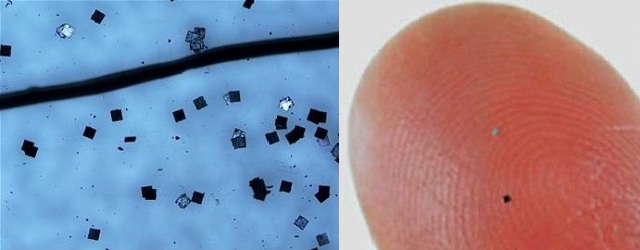
Hitachi's new RFID chips (left, next to a human hair) are 64x smaller than their mu-chips (right)
By relying on semiconductor miniaturization technology and using electron beams to write data on the chip substrates, Hitachi was able to create RFID chips 64 times smaller than their currently available 0.4 x 0.4 mm mu-chips. Like mu-chips, which have been used as an anti-counterfeit measure in admission tickets, the new chips have a 128-bit ROM for storing a unique 38-digit ID number.
The new chips are also 9 times smaller than the prototype chips Hitachi unveiled last year, which measure 0.15 x 0.15 mm.
At 5 microns thick, the RFID chips can more easily be embedded in sheets of paper, meaning they can be used in paper currency, gift certificates and identification. But since existing tags are already small enough to embed in paper, it leads one to wonder what new applications the developers have in mind.
[Source: Fuji Sankei]

 Japanese clothing manufacturer Gunze has announced the establishment of an underwear knowledge certification test called the Gunze Pantsu Kentei, which they will begin offering on March 1.
Japanese clothing manufacturer Gunze has announced the establishment of an underwear knowledge certification test called the Gunze Pantsu Kentei, which they will begin offering on March 1. 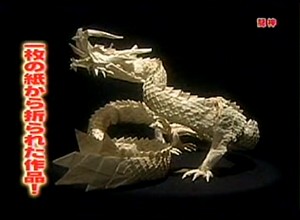 Check out this
Check out this 
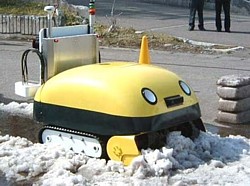 The friendly-looking Yuki-taro measures 160 x 95 x 75 cm (63 x 37 x 30 in.) and weighs 400 kg (880 lbs). Armed with GPS and a pair of video cameras embedded in its eyes, the self-guided robot seeks out snow and gobbles it up into its large mouth. Yuki-taro's insides consist of a system that compresses the snow into hard blocks measuring 60 x 30 x 15 cm (24 x 12 x 6 in.), which Yuki-taro expels from its rear end. The blocks can then be stacked and stored until summer, when they can be used as an alternative source of refrigeration or cooling.
The friendly-looking Yuki-taro measures 160 x 95 x 75 cm (63 x 37 x 30 in.) and weighs 400 kg (880 lbs). Armed with GPS and a pair of video cameras embedded in its eyes, the self-guided robot seeks out snow and gobbles it up into its large mouth. Yuki-taro's insides consist of a system that compresses the snow into hard blocks measuring 60 x 30 x 15 cm (24 x 12 x 6 in.), which Yuki-taro expels from its rear end. The blocks can then be stacked and stored until summer, when they can be used as an alternative source of refrigeration or cooling. 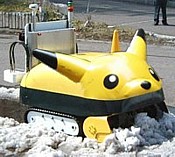

 On February 6, Nippon Oil (ENEOS), Toyota Motors, Hino Motors and the Tokyo Metropolitan Government announced the launch of a joint project aimed at putting bio hydrofined diesel (also known as BHD, or second-generation biodiesel) into practical use. In 2007, the city will begin trial operation of city buses that run on a 10% BHD-diesel blend.
On February 6, Nippon Oil (ENEOS), Toyota Motors, Hino Motors and the Tokyo Metropolitan Government announced the launch of a joint project aimed at putting bio hydrofined diesel (also known as BHD, or second-generation biodiesel) into practical use. In 2007, the city will begin trial operation of city buses that run on a 10% BHD-diesel blend. 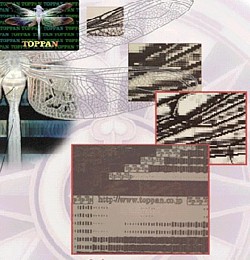 On February 1,
On February 1, 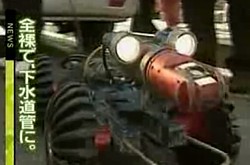 This story is not from Japan, but I couldn't resist...
This story is not from Japan, but I couldn't resist...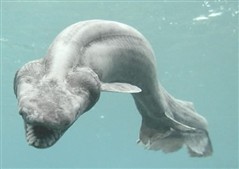 On the afternoon of January 21, a fisherman spotted the large fish in the shallow water near the park. He immediately contacted Awashima Marine Park officials, who caught the shark and transported it to the park's dolphin pen, where they turned it loose. The weak shark was able to survive for several hours -- long enough for park officials to videotape it swimming around. Video footage of the frilled shark near the sea surface is very rare, and the park says it will keep the video for research purposes.
On the afternoon of January 21, a fisherman spotted the large fish in the shallow water near the park. He immediately contacted Awashima Marine Park officials, who caught the shark and transported it to the park's dolphin pen, where they turned it loose. The weak shark was able to survive for several hours -- long enough for park officials to videotape it swimming around. Video footage of the frilled shark near the sea surface is very rare, and the park says it will keep the video for research purposes.